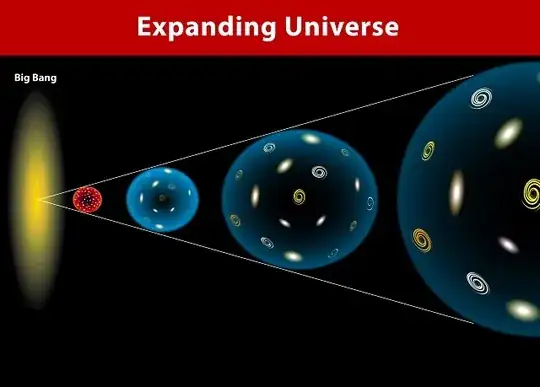When one considers different big bangs as explosions that could collide with each other then it mean that there has to be some space between the two big bangs that can be crossed by the stuff coming from the respective big bang explosions. However, that would imply that the big bangs do not happen through all of space. Instead, one gets the picture of localized explosions happening at some distances from each other. This is not the general view of what a big bang is.
Now, to avoid confusion, I'm first going to talk from within the perspective of the standard view of one universe that was created by a (one) big bang. I'm also going to assume that this space of the universe is finite and not infinite. Like a ball. Although the surface of a ball is finite, it has no boundaries. So let's assume that the entire universe has a finite volume without boundaries. In this case, the entire universe started from a situations where the volume of this space was very small, theoretically infinitesimally small (however, we don't know this for sure because we cannot observe it that far back). Then this volume started to expand, doesn't matter whether you want to include inflation in the model or not. Bottom line is, it expanded to the huge volume that we observe today. So the big bang is simply this expansion of the volume. It is not that the universe expanded (or exploded) in some existing space. The universe is the space and there is nothing beyond it. What if it is not like a ball, but actually does have an infinite volume. Not a big difference. One just needs to understand that one cannot talk about a small initial volume in such a case, but one can still have the expansion.
Now, to deal with all those caveats. One is the scenario that John Rennie explains. In this case, the entire universe did not start from an infinitesimal volume, but rather with some finite volume that is at least big enough so that one can identify different regions. Some localized regions then started to expand as if they are universes all by themselves. In this case there would be space between the regions that are undergoing expansions. However, for these regions to be colliding, the intervening space need to be shrinking otherwise the expanding regions would never touch each other. This is not the conventional understanding of a big bang, because this does not involve all of space. This is therefore a little bit more like an actual explosion. It is also a little unscientific, because the chances to get any scientific observations that can test this theory is extremely small.
Going even further a field, one finds the notion of a multi-verse, also called parallel universes. In this case however, each universe has its own space that does not have to be connected in any way with any other universe. As a result, each one can expand at will without ever encountering any of the other universes. Of course, one can dream up many different conceivable ways in which these universe may somehow affect each other. However, again this is rather unscientific, because of the general lack of any scientific evidence to support such notions.
